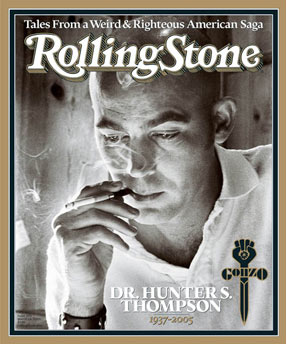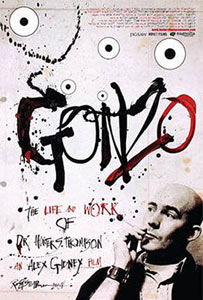The Gonzo Tapes: The Life and Work of Dr. Hunter S. Thompson
Published on January 30th, 2009 in: Book Reviews, Books, Culture Shock, Issues, Retrovirus, Reviews, Underground/Cult |By Lisa Haviland
“For me, it was the first time I’d ever even heard an artillery shell fired and when they come in and hit, it’s a, ah, unnerving experience. . . When you’re out in a jeep that continually backfires and boils over and stops by the side of the road in the midst of voluntary convoys and hoards of refugees, yeah, you tend to think that maybe the world is about to come to an end.”
That’s Hunter S. Thompson reporting on the state of Saigon, Vietnam, circa 1975. He traveled there at the urging of New York Times war correspondent Gloria Emerson, as documented on The Gonzo Tapes. Emerson’s idea was for Thompson to expand on the paradigm of Fear and Loathing in Las Vegas, first published as a two-part Rolling Stone series in 1971, by writing about Saigon’s last days at the close of the Vietnam War. As the tapes reveal, however, Thompson’s method was more akin to participatory journalism—with some severe twists—than anything that could really be planned ahead of time. After all, he originally traveled to Las Vegas in 1971 to write photo captions on the Mint 400 for Sports Illustrated.

The Gonzo Tapes capture the spirit of Thompson’s journalism, which, despite the colossal impact of the frenzied Fear and Loathing, hinged more on the purity of experience than the excesses of one infamous trip. As Thompson remarked on tape to Jann Wenner, founder and editor-in-chief of Rolling Stone, prior to the novel’s release, “I couldn’t get a hotel room if that thing came out right now.” The image of Hunter S. Thompson as the chaos-inducing, semi-deranged version of himself portrayed by Johnny Depp, a.k.a. Raoul Duke, may be the one that endures, but that version only captures one aspect of the man.
Thompson’s reflections on Vietnam, which were not published until ten years after the fact, adhere to his predominant style of alternately reporting on and reacting to events, rather than creating them, as he arguably did in Vegas—and even then, one might say he was becoming his environment, a rider in the storm with a megaphone. He wasn’t out there just partying, though obliteration in the face of absurdity was certainly an aspect of his trip, yet many seem to cling to and celebrate the boozing and drugging at the expense of his body of work as a whole. After listening to these tapes, Bill Murray’s depiction of Thompson in Where the Buffalo Roam struck me as an even more accurate rendering of the intelligent, droll, weird, erratic, and strangely calm-sounding journalist, whose earlier subjects, such as the Hell’s Angels and Richard M. Nixon, were much less lucid.

The opening track finds Thompson crouched in his car at the outskirts of an Angels event in Bass Lake, California, partly to be audible on tape amid their screams and whoops and partly because “the sight of this thing would drive them to madness—they’d burn the machine.” He was able to infiltrate the group while researching Hell’s Angels: A Strange and Terrible Saga, though he held few illusions about the potential danger of the association. The precarious nature of his position—an outsider documenting a notorious group in an open capacity, rather than an undercover one—and the alternate disconnect and overlap between the American public’s perceptions of the Angel’s crimes and their actual crimes transcended the standard boundaries of popular journalism. As Thompson explains:
“The situation doesn’t fit them: they’re either more guilty than they really are by the law or they’re less guilty. It’s obvious now that this is a very peculiar situation for the town of Bass Lake—the resort area of Bass Lake—to handle. And yet the Angels are so far not guilty of anything; they’re a bunch of good, fun-loving American lads out riding their motorcycles around the state and having a good time, out here for a Fourth of July camping trip. But there’s so much more to it that the law simply does not cover.”
That sort of gray area is where Thompson thrived as a writer, his eventual beating by a group of Angels notwithstanding, and dwelling there required him to take risks that many were not willing to take or, in post-9/11 America, are not allowed to take. Most of the recordings are culled from the 1970s, Thompson’s most prolific period, and some of the practices he railed against, such as disingenuous flaks and poor event organization, have become accepted norms today. As he remarked during the 2004 presidential campaign, “Richard Nixon looks like a flaming liberal today, compared to a golem like George Bush.” While Thompson notes on tape that he did not take what he perceived to be unnecessary risks, he also makes it plain that he was aware that many deemed the risks he did undertake too dangerous, but that he did not take them to be reckless. In deciding to re-enter Saigon when so many correspondents had fled, the good doctor mused:
“If the worst happens, well, it just happens. I’ve been pushing it for a while—about ten years now, 15, 20. I’m not looking for the end, but I’m not worried about it, either. I had a good time and made a few points. And I don’t know if that justifies doing kill-crazy things, or suicidal things, but if I really thought it was suicidal, I wouldn’t go back in. But the fact is that it’s not safe. There are a lot of people who know the situation better than I do who would call it suicidal. And they all left and they admitted they just didn’t want any part of a suicide orgy. I don’t think many of the people over there do, although I’d say there’s easy ten to 20 percent who would welcome it for reasons of their own. I don’t know those reasons; I like my life, I enjoy it, but I’ve come this far and it’s my story and. . . I think I’ll just run with this one, which means going right back into the eye of the storm. And it will be a storm. We don’t have much doubt about that.”
For my friend and fellow apocalypse comrade, Bruce Pennington.
Additional Resources:
The Gonzo Tapes are available from Shout! Factory.
RELATED LINKS:
A “Very” Exclusive Interview With Dr. Hunter S. Thompson, Popshifter November/December 2008 issue
Time limit is exhausted. Please reload the CAPTCHA.